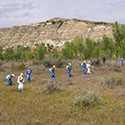(SAULT STE. MARIE, ON – July 5, 2016): An Algoma University researcher was part of a team from Canada and the U.S. that studied herbicide usage on wildlands.
“Herbicide usage is a very important topic because it has social, environmental and economic implications. This is the first study to analyze herbicide use on wildlands across North America for non-native invasive plant management, and our team was surprised at the results,” says Dr. Pedro Antunes, Associate Professor and Canada Research Chair in Invasive Species Biology at Algoma University and co-author of the study.
They found that a total of 1,233,434 acres of wildlands were sprayed and a whopping 201 tons of herbicides were used in 2010 alone. When asked about the relevance of these findings, former visiting Post-Doctoral Researcher at Algoma University Viktoria Wagner explains: “Although the numbers are much smaller than those for croplands, they are astonishing. They indicate that the wildland area sprayed is comparable to 462,963 soccer fields and the equivalent to the weight of approximately 20 school buses. However, it is very likely that the actual numbers are much higher since we did not have access to all data.”
Herbicides were originally developed to suppress weeds in agricultural crops. Today they are widely used in wildlands to control non-native plants because the latter can cause considerable ecological and economic harm. While the magnitude of herbicide usage is well documented for croplands, little is known about herbicide application in wildlands for control of non-native plants.
The study was based on a survey among government offices and agro-statistical companies in the U.S., Canada and Mexico. “It involved a lot of e-mails and phone calls to get the data we wanted,” says Wagner, who led the study, “but the effort was worthwhile.”
Another important finding was that glyphosate ranked as one of the most commonly used active ingredients. This finding was unexpected because glyphosate is a non-selective herbicide that harms grasses and herbs alike, and thus has a higher potential to negatively affect desired native plants. The authors link its wide popularity to certain chemical properties, its low price and low usage restrictions.
Their publication was not just about presenting data. The authors also make a strong case for filling an important knowledge gap in wildland management. Dr. Antunes says “I was surprised to find that no data were available for Canada. We hope that our paper can contribute towards the development of new policies and mechanisms aimed at tracking herbicide usage in wildlands. This is critical to ensure that we can measure the full range of costs and benefits associated with spraying herbicide specifically for non-native invasive plant control in wildlands.”
This study was supported by an Ontario Ministry of Natural Resources and Forestry and the Invasive Species Centre grant, and by a postdoctoral fellowship to Viktoria Wagner from the Alexander von Humboldt Foundation.
The team of Canadian researchers consisted of Pedro M. Antunes of Algoma University and Michael Irvine of the Ontario Ministry of Natural Resources. The team of U.S. researchers included Viktoria Wagner and Cara R. Nelson of the University of Montana.
Share Article




